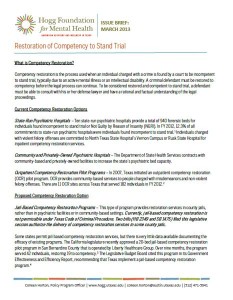Policy Brief: Competency Restoration
Introduction
What is Competency Restoration?
Competency restoration is the process used when an individual charged with a crime is found by a court to be incompetent to stand trial, typically due to an active mental illness or an intellectual disability. A criminal defendant must be restored to competency before the legal process can continue. To be considered restored and competent to stand trial, a defendant must be able to consult with his or her defense lawyer and have a rational and factual understanding of the legal proceedings.
Proposed Competency Restoration Option
Jail-Based Competency Restoration Programs – This type of program provides restoration services in county jails, rather than in psychiatric facilities or in community-based settings. Currently, jail-based competency restoration is not permissible under Texas Code of Criminal Procedure. Two bills (HB 2349 and SB 1475) filed this legislative session authorize the delivery of competency restoration services in some county jails.
Some states permit jail-based competency restoration services, but there is very little data available documenting the efficacy of existing programs. The California legislature recently approved a 20-bed jail-based competency restoration pilot program in San Bernardino County that is operated by Liberty Healthcare Group. Over nine months, the program served 42 individuals, restoring 19 to competency. The Legislative Budget Board cited this program in its Government Effectiveness and Efficiency Report, recommending that Texas implement a jail-based competency restoration program.
Considerations for Jail-Based Competency Implementation
Choosing the right candidates – OCR programs provide treatment in the least restrictive setting at a significantly lower cost than jail-based programs. Texas’ OCR programs have a greater success rate than the California jail-based program. Approximately 66% of individuals served in OCR are either restored to competency or see improvement before charges are dropped. Only 45% of individuals served in San Bernardino County’s jail attain competency while committed. Where OCR programs are available, individuals who would be eligible for bail should be referred to OCR programs for competency restoration. Individuals who present a greater security or flight risk, but who do not need intensive inpatient restoration services, are good candidates for jail-based programs.
Differences in treatment setting – County jails are not the optimal setting for providing mental health treatment. Some successful jail-based competency restoration programs operate in specialized detention units that better facilitate the delivery of services and the observation of detainees. They also provide supplemental training for staff and maintain an adequate number of licensed mental health professionals on the unit. Jail-based competency restoration programs should only be implemented in counties with programs that have adequate staffing ratios and the overall capacity to provide these services. Additionally, stringent monitoring and accountability is critical if jail restoration services are developed and privatized.
Separation of evaluators and treatment providers – Private providers of jail-based competency restoration services have inherent incentives to hold individuals in jail-based competency restoration programs for longer than necessary, as their compensation is generally based on total days in the jail. In order to avoid a conflict of interest, Texas should require independent evaluators and independent recommendations for any private provider of jail-based competency restoration service.

